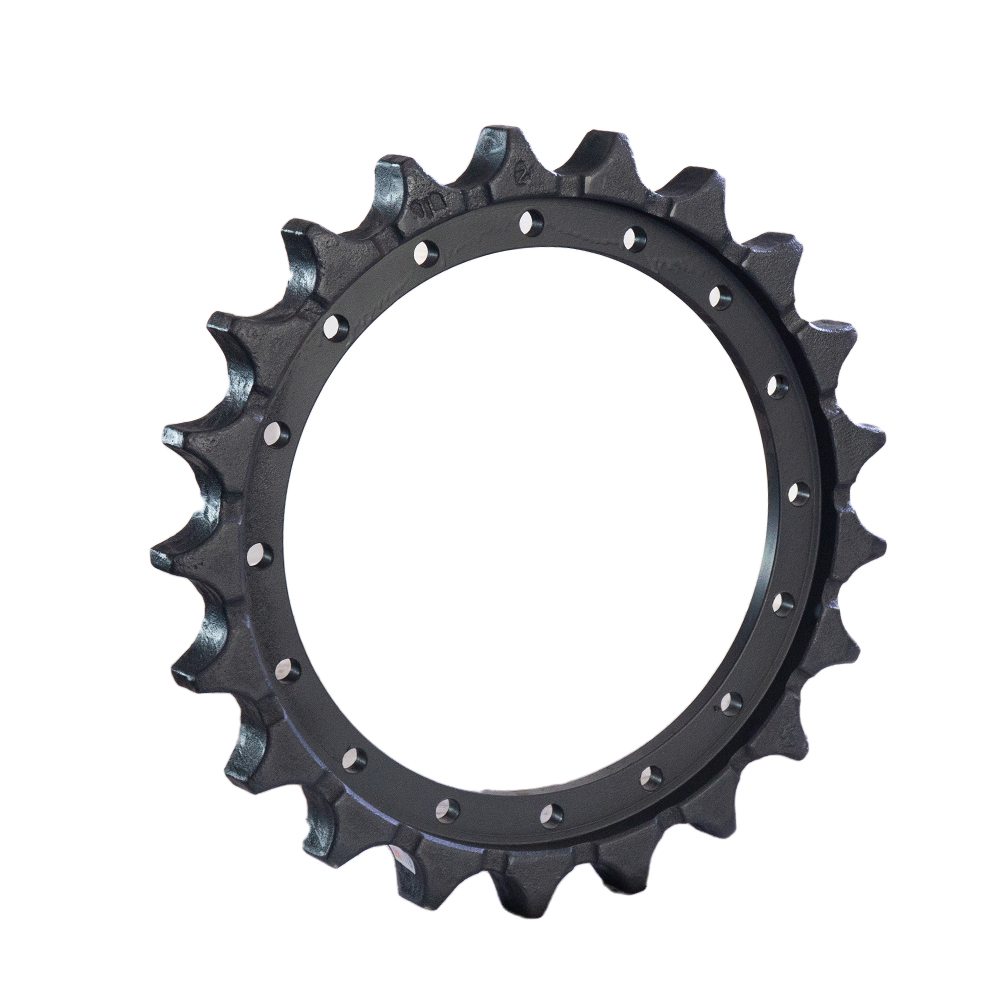Several factors can contribute to sprocket failure or premature wear in an excavator undercarriage system. Here are some potential causes:
Insufficient Lubrication: Inadequate lubrication of the sprocket and the contact surfaces between the sprocket teeth and track chains can lead to increased friction, heat generation, and accelerated wear. Insufficient lubrication may result from improper lubricant selection, infrequent lubrication intervals, or failure to follow manufacturer-recommended lubrication practices.
Contamination: The presence of dirt, debris, abrasive particles, or moisture in the undercarriage system can contribute to sprocket wear. Contamination can cause abrasive action between the sprocket teeth and track chains, leading to accelerated wear and potential damage.
Improper Track Tension: Incorrect track tension can put excessive stress on the sprocket. Insufficient tension can cause the sprocket teeth to slip and wear unevenly, while excessive tension can lead to increased loads on the sprocket, accelerating wear.
Misalignment: Improper alignment of the sprocket with the track chain can result in uneven contact between the sprocket teeth and track links. Misalignment can cause concentrated wear on specific areas of the sprocket, leading to premature failure.
Overloading: Operating the excavator in conditions that exceed its recommended load capacity can put excessive stress on the sprocket. Overloading can cause accelerated wear, deformation, or even breakage of the sprocket teeth.
Poor Quality or Incorrect Sprocket Design: Low-quality materials or substandard manufacturing processes can result in weaker sprockets that are more prone to premature wear or failure. Similarly, using sprockets that are not designed specifically for the excavator model or undercarriage system can lead to compatibility issues and increased wear.
Harsh Operating Conditions: Operating the excavator in harsh environments, such as rocky terrains or highly abrasive surfaces, can accelerate sprocket wear. Additionally, extreme temperature variations, corrosive substances, or exposure to water or moisture can contribute to premature sprocket failure.
Lack of Maintenance: Inadequate or irregular maintenance practices, such as infrequent inspections, failure to address early signs of wear, or neglecting to replace worn sprockets in a timely manner, can result in accelerated wear and potential failure.
To minimize sprocket failure and premature wear, it is essential to follow proper maintenance practices, including regular lubrication, inspection for contamination, proper track tensioning, alignment checks, and prompt replacement of worn or damaged sprockets. Additionally, operating the excavator within its recommended load capacity and avoiding harsh operating conditions can help extend the sprocket’s lifespan.
What maintenance procedures should be followed to prolong the lifespan of the sprocket?
To prolong the lifespan of the sprocket in an excavator undercarriage system, it is important to follow proper maintenance procedures.
Here are some key maintenance steps that can help extend the sprocket’s lifespan:
Lubrication: Regular and proper lubrication is crucial for reducing friction and wear between the sprocket teeth and track chains. Follow the manufacturer’s recommendations for the type of lubricant to use and the recommended lubrication intervals. Ensure that the sprocket and track chain surfaces are adequately coated with lubricant.
Cleanliness: Keep the undercarriage system clean and free from dirt, debris, and other contaminants. Regularly remove any buildup of mud, rocks, or other materials that can cause abrasive action and accelerate sprocket wear. Use a pressure washer or other appropriate cleaning methods to maintain cleanliness.
Inspection: Regularly inspect the sprocket for signs of wear, damage, or misalignment. Look for uneven wear patterns, excessive tooth wear, cracks, or missing teeth. CATERPILLAR CAT320 Excavator Undercarriage Part Sprocekt manufacturer Inspect the sprocket teeth and track chain contact surfaces for signs of excessive wear or damage. Detecting and addressing issues early can prevent further damage and extend the sprocket’s lifespan.
Track Tension: Maintain proper track tension according to the manufacturer’s recommendations. Incorrect track tension can put unnecessary stress on the sprocket, leading to accelerated wear. Regularly check and adjust the track tension as needed to ensure optimal performance and minimize sprocket wear.
Alignment: Check the alignment of the sprocket with the track chain. Misalignment can result in uneven wear and premature sprocket failure. If misalignment is detected, consult the manufacturer’s guidelines or seek professional assistance to correct the alignment.
Replacement: Monitor the sprocket’s wear condition and replace it when necessary. Worn sprockets can cause increased wear on the track chains and other undercarriage components. Follow the manufacturer’s recommendations or consult with a qualified technician to determine the appropriate timing for sprocket replacement based on wear limits.
Operating Practices: Adopt proper operating practices to minimize stress on the sprocket. Avoid overloading the excavator beyond its recommended capacity, and operate in a manner that minimizes impacts, sudden direction changes, and excessive spinning of the tracks, which can contribute to sprocket wear.
Documentation: Keep a record of maintenance activities, including lubrication schedules, inspections, adjustments, and replacements. This documentation helps track the maintenance history and aids in identifying patterns or issues that may arise over time.
By following these maintenance procedures, you can effectively care for the sprocket and maximize its lifespan, ensuring optimal performance and reducing the risk of premature wear or failure.
